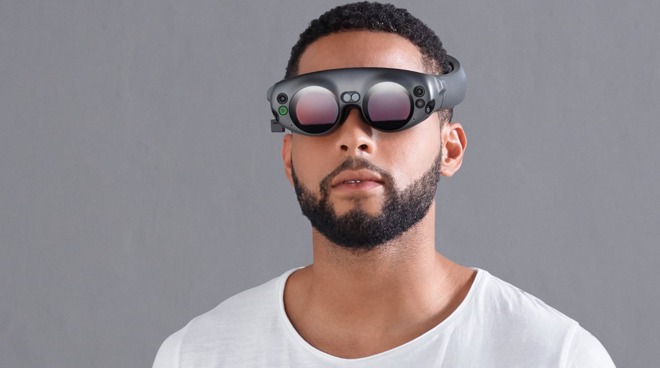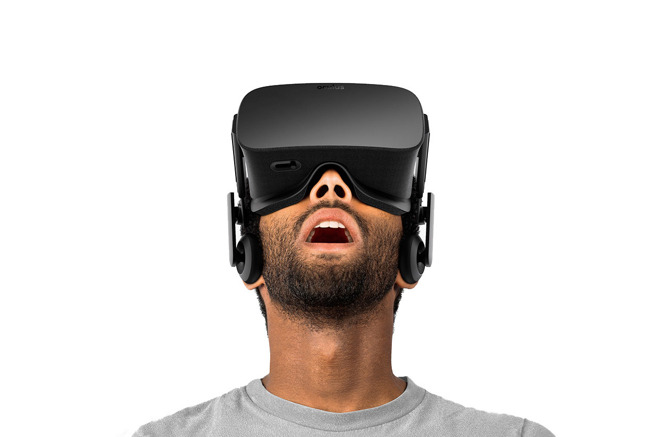Apple VR headset for $1,000 arrives in 2022, a year ahead of 'Apple Glass'
Reportedly facing design and development issues, "Apple Glass" may now be preceded by a separate Apple VR headset that will be an expensive rival to Oculus.

The Magic Leap One Lightwear AR goggles, an example of an AR headset
The forthcoming "Apple Glass" AR headset has reportedly hit more than one hurdle in its development and may now be beaten to market by an alternative Apple device. This is expected to be a heavier, more familiar-looking VR headset, akin to Oculus or PlayStation VR, but more expensive.
According to Bloomberg, Apple plans to launch this new headset in 2022, and price it above the $300 to $900 of its rivals. It's believed that Apple expects this to only sell in low volumes, reportedly only one headset per day per Apple Store, similar to how the Mac Pro sells now.
The headset is said to be codenamed N301 and is said to be in the late prototype stage. It's claimed that the headset will contain processors that out-perform the Apple M1 chips in the new Apple Silicon Macs.
"Apple Glass," codenamed N431, on the other hand, are reportedly said to be in a pre-prototype stage known as "architecture." This means Apple is still at the stage of developing underlying "Apple Glass" technologies instead of physical devices.
Apple has been working on different designs of headsets for many years, with Jony Ive reportedly delaying one over design concerns.
His chief disagreement with Apple's plans at the time was that the company wanted to release a two-part system. There would be a headset and a separate device that would contain the processors.
According to Bloomberg, one issue with bundling the processors into the single headset design of "Apple Glass" has been that it made the device heavy. Reportedly, early testing raised issues over neck strain.

Oculus Rift VR headset
Apple has also previously been reported to be working on auto-adjusting "Apple Glass" sets that would remove the need for prescription lenses. Bloomberg says that in the current design, Apple has reduced the size by removing the space that VR headsets typically keep for prescription lenses.
This could mean that Apple is confident of its alternative to prescription lenses. However, it would raise issues over setting up the lenses when buying at an Apple Store or online. And different countries have different series of regulations regarding such lenses, which Apple would most likely have to address so that one single device could be sold everywhere.
This isn't the first report that Apple may not start its wearable AR headset plans with the expected "Apple Glass." In September 2020, Jean-Louis Gassee predicted Apple would start with Virtual Reality goggles.

The Magic Leap One Lightwear AR goggles, an example of an AR headset
The forthcoming "Apple Glass" AR headset has reportedly hit more than one hurdle in its development and may now be beaten to market by an alternative Apple device. This is expected to be a heavier, more familiar-looking VR headset, akin to Oculus or PlayStation VR, but more expensive.
According to Bloomberg, Apple plans to launch this new headset in 2022, and price it above the $300 to $900 of its rivals. It's believed that Apple expects this to only sell in low volumes, reportedly only one headset per day per Apple Store, similar to how the Mac Pro sells now.
The headset is said to be codenamed N301 and is said to be in the late prototype stage. It's claimed that the headset will contain processors that out-perform the Apple M1 chips in the new Apple Silicon Macs.
"Apple Glass," codenamed N431, on the other hand, are reportedly said to be in a pre-prototype stage known as "architecture." This means Apple is still at the stage of developing underlying "Apple Glass" technologies instead of physical devices.
Apple has been working on different designs of headsets for many years, with Jony Ive reportedly delaying one over design concerns.
His chief disagreement with Apple's plans at the time was that the company wanted to release a two-part system. There would be a headset and a separate device that would contain the processors.
According to Bloomberg, one issue with bundling the processors into the single headset design of "Apple Glass" has been that it made the device heavy. Reportedly, early testing raised issues over neck strain.

Oculus Rift VR headset
Apple has also previously been reported to be working on auto-adjusting "Apple Glass" sets that would remove the need for prescription lenses. Bloomberg says that in the current design, Apple has reduced the size by removing the space that VR headsets typically keep for prescription lenses.
This could mean that Apple is confident of its alternative to prescription lenses. However, it would raise issues over setting up the lenses when buying at an Apple Store or online. And different countries have different series of regulations regarding such lenses, which Apple would most likely have to address so that one single device could be sold everywhere.
This isn't the first report that Apple may not start its wearable AR headset plans with the expected "Apple Glass." In September 2020, Jean-Louis Gassee predicted Apple would start with Virtual Reality goggles.


Comments
The Quest 2 and pricing are attractive but Facebook screwed up by trying to force users into their claws.
I don't mind using WhatsApp or Oculus 'by' Facebook but I don't want to be full on inside Facebook.
I hope I'm not alone and others have shelved purchase plans. There is now hopefully a self induced gaping hole in the market for others to fill.
Apple could do it but only if they get pricing right along with a couple of other vital elements:
Battery life
Image quality
Keeping the device from overheating
Now, if there is some compelling use case besides gaming that factors in (which most assuredly could exist in spite of my inability to see it), then what I've outlined above might not be completely relevant, or might be irrelevant entirely.
I can see a use case if such a headset could be attached to a Mac or Mac Mini and used to create multiple virtual screens, providing the quality of such a virtual display could approach a real one. With good hand tracking (similar to what the Quest 2 offers at the moment), virtual keyboards, mice, trackpads, styli, and other input "devices" (a la Minority Report) that I can't imagine at the moment would be possible. Might not be a market disruption like many other Apple devices, but it would be highly useful to some people.
Apple seems to be under the impression their announcement of a major new technology or API will cause devs to flood to the Mac specifically to use it, and when that doesn't immediately happen they leave the devs that are using the new tech in the lurch for a few years, then all mention vanishes from Apple's website and the API gets deprecated for the next shiny new thing. Ultimately this makes devs even less likely to begin development for the Mac in the future.
The Valve Index has a 120º diagonal field of view, and ~2153 pixel diagonal dimension. Just under 18 pixels per degree, or 0.05574706097º per pixel. That's 3.34 arcminutes (also called minutes of arc) per pixel. Normal human visual acuity (20/20 or 6/6) is defined as the ability to resolve a visual pattern spaced at 1 arcminute. Assuming pixel-perfect orientation and placement, the Index provides about 20/80 (or 6/24) vision.
Is Apple willing to go all in with Apple VR? We’ll see...
At $1000, what market is Apple targeting? Consumers may pay a small premium for an Apple VR headset but will it really be more than three times as good as an Oculus Quest 3 in 2022?